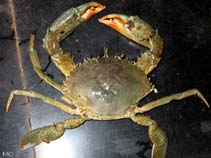Scylla serrata (Forsskål, 1775)
Indo-Pacific swamp crab| Native range | All suitable habitat | Point map | Year 2050 |

|
| This map was computer-generated and has not yet been reviewed. |
| Scylla serrata AquaMaps Data sources: GBIF OBIS |
Classification / Names Common names | Synonyms | CoL | ITIS | WoRMS
Malacostraca | Decapoda | Portunidae
Environment: milieu / climate zone / depth range / distribution range Ecology
Benthic; brackish; depth range 0 - 50 m (Ref. 343). Tropical; 26°C - 30°C (Ref. 111153), preferred 25°C (Ref. 107945); 34°N - 37°S, 22°E - 134°W
Distribution Countries | FAO areas | Ecosystems | Occurrences | Introductions
Indo-West Pacific. Introduced in Hawaii and USA.
Length at first maturity / Size / Weight / Age
Maturity: Lm 6.9, range 8 - ? cm Max length : 28.0 cm CW male/unsexed; (Ref. 343); max. published weight: 3.0 kg (Ref. 343)
Short description Morphology
Carapace smooth, with strong transverse ridges; H-shaped gastric groove deep; relatively broad frontal lobes, all more or less in line with each other; broad anterolateral teeth, projecting obliquely outwards. Well-developed present on outer surface of chelipedal carpus and anterior and posterior dorsal parts of the palm. Color: carapace green to almost black; legs may be marbled.
Maximum carapace width: between 25 and 28 cm. Maximum weight between 2 and 3 kg. Also collected by baited wire mesh pots. Sold in Taiwan, Hong Kong and Singapore, where the large crabs (so called "meat crabs") and females with ripe ovaries ("roe crabs") command a price from US$5 to US$10 per kg. Largest exporters of this species are Indonesia, Sri Lanka, India, and Bangladesh. There have been attempts to culture the crabs in captivity, but none of the closed-cycle enterprise have gone commercial. Tide is relied upon by farms to bring megalopae or late zoeae into grow-out ponds.
Life cycle and mating behavior Maturity | Reproduction | Spawning | Eggs | Fecundity | Larvae
Gonochoric; sexually dimorphic based on secondary characteristics. The male traps the female under its chest, holding the latter with its chelipers, forming a pair. When the female is about to molt, the male releases but remains nearby. After moulting, the female is again trapped by the male and the latter opens its genitals towards the female's abdomen. Coupling may last from seven to twelve hours (Ref. 99880) and occurs at the bottom of the burrows; spawning occurs five weeks after mating. Migration: young crabs (2 cm CL) attend to estuarine waters and leave to enter the mangroves at lengths 7-9 cm for males and 8 cm for females; after which they return to the sea (Ref. 99886).
Main reference
References | Coordinator | Collaborators
Ng, P.K.L. 1998. (Ref. 343)
IUCN Red List Status (Ref. 130435: Version 2024-1)
CITES status (Ref. 108899)
Not Evaluated
CMS (Ref. 116361)
Not Evaluated
Threat to humans
Human uses
Fisheries: commercial
FAO - Aquaculture: production, species profile; Fisheries: landings, species profile | FishSource | Sea Around Us
Tools
More information
Trophic Ecology
Ecology
Population dynamics
Life cycle
Human Related
Aquaculture profile
Stamps, Coins Misc.
Stamps, Coins Misc.
Outreach
References
Internet sources
BHL | BOLD Systems | CISTI | DiscoverLife | FAO(Aquaculture: species profile; Fisheries: species profile; publication : search) | Fishipedia | GenBank (genome, nucleotide) | GloBI | Gomexsi | Google Books | Google Scholar | Google | PubMed | Tree of Life | Wikipedia (Go, Search) | Zoological Record
Estimates based on models
Preferred temperature
(Ref. 115969): 24.5 - 29.1, mean 28.1 (based on 1290 cells).
Resilience
(Ref. 69278):
High, minimum population doubling time less than 15 months (K=0.43).
Prior r = 1.17, 95% CL = 0.77 - 1.75, Based on 3 data-limited stock assessments.
Nutrients : Calcium = 109 [35, 184] mg/100g; Iron = 1.59 [1.21, 1.97] mg/100g; Protein = 20.2 [19.2, 21.3] %; Omega3 = 0.285 [0.185, 0.386] g/100g; Selenium = 48.3 [-31.7, 128.3] μg/100g; VitaminA = 0 μg/100g; Zinc = 1.79 [1.17, 2.40] mg/100g (wet weight); based on nutrient studies.



